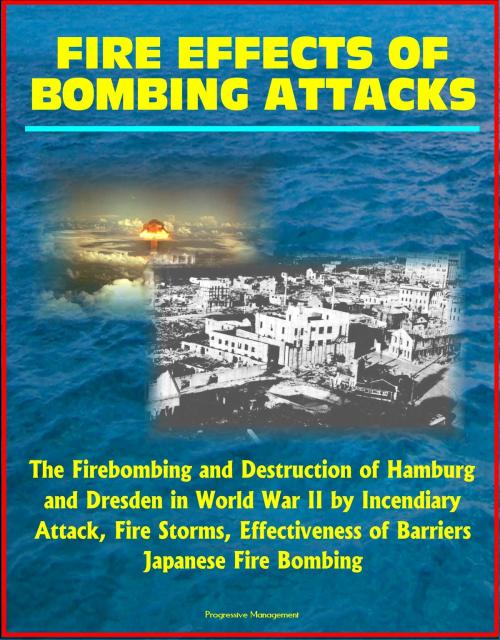Fire Effects of Bombing Attacks: The Firebombing and Destruction of Hamburg and Dresden in World War II by Incendiary Attack, Fire Storms, Effectiveness of Barriers, Japanese Fire Bombing
Nonfiction, History, Military, World War II| Author: | Progressive Management | ISBN: | 9781301442027 |
| Publisher: | Progressive Management | Publication: | February 6, 2013 |
| Imprint: | Smashwords Edition | Language: | English |
| Author: | Progressive Management |
| ISBN: | 9781301442027 |
| Publisher: | Progressive Management |
| Publication: | February 6, 2013 |
| Imprint: | Smashwords Edition |
| Language: | English |
The great fire attacks on the cities of Germany and Japan were scientifically planned with emphasis placed on the susceptibility of the target and the type and quantity of munitions necessary to produce maximum damage. The lessons learned from these attacks and later from the atomic bomb attacks on Hiroshima and Nagasaki should provide valuable guidance to planners in designing measures to minimize the effects of fire damage to American cities in any future war.
Complete appraisal of the fire damage in German cities may never be made. The best figures for total damage due to high-explosive and incendiary bombs were compiled from aerial surveys made by the British Air Ministry. Although admittedly incomplete, records of the principal attacks on most cities were included. Of the 49 cities studied, 39 percent of the individual dwelling units (2,164,800 out of a total of 5,554,500) were seriously damaged.
Both high-explosive and incendiary bombs were used in the great attacks on German targets by the U. S. Army Air Force and the Royal Air Force. The high-explosive bombs varied in size from 100 to 2,000 pounds (with heavier bombs for special targets). The incendiary bombs varied from 4 to 100 pounds (with some 500-pound bombs used on industrial installations) and were of two general types, namely: (1) Those in which the container was combustible and served as incendiary material, and (2) those in which the case was merely a container capable of placing the incendiary filling at the desired place in the target.
In the principal city attacks the total load of bombs dropped consisted of an approximately equal weight of high explosives and incendiaries. High-explosive bombs deterred firefighting, disrupted communications, broke water-main networks, created road blocks, opened up buildings, broke windows, and displaced roofing. In some places they caused fires, but this was a secondary and relatively minor factor. The incendiaries started most of the fires.
Bomb loads of 1,000 to 2,000 tons were dispatched over German cities in one night. A total of over 7,000 tons was dropped on Hamburg, and an even heavier bomb load was dropped on Dresden in the closing days of the war. In contrast, the heaviest single attack on an English city was 457 tons of incendiary and high-explosive bombs dropped on London on the night of April 16-17, 1941. These figures show that the German attacks on England were relatively light despite the great damage they caused.
Contents: Section I * Fire Warfare in World War II * Fire Warfare on German Cities * The Pattern of German Cities * Characteristics of Fire Storms * Fire Spread * Fire Defense Operations * Casualties * Fire Warfare on Japanese Cities * The Pattern of Japanese Cities * Characteristics of Conflagrations * Fire Spread * Firebreaks * Fire Defense Operations * Casualties * Fire from the Atomic Bomb Attacks on Hiroshima and Nagasaki, Japan * The Pattern of the Cities of Hiroshima and Nagasaki * Fires Caused by the Atomic Bomb * Fire Defense Operations * Casualties * Section II * Principal Factors Involved in the Fire Susceptibility of American Cities * Factors Having the Greatest Influence on Fire Initiation and Fire Spread * 1. Building Density * 2. Combustibility of Structures * 3. Firebreaks * 4. Size of Target Area * Contributing Factors to Fire Initiation and Fire Spread * 1. Continuity of Combustible Construction * 2. Occupancy Combustibility * 3. Size of Buildings * 4. Topography * Weather Factors * 1. Humidity * 2. Rain and Snow * 3. Wind * Conclusions * Bibliography
The great fire attacks on the cities of Germany and Japan were scientifically planned with emphasis placed on the susceptibility of the target and the type and quantity of munitions necessary to produce maximum damage. The lessons learned from these attacks and later from the atomic bomb attacks on Hiroshima and Nagasaki should provide valuable guidance to planners in designing measures to minimize the effects of fire damage to American cities in any future war.
Complete appraisal of the fire damage in German cities may never be made. The best figures for total damage due to high-explosive and incendiary bombs were compiled from aerial surveys made by the British Air Ministry. Although admittedly incomplete, records of the principal attacks on most cities were included. Of the 49 cities studied, 39 percent of the individual dwelling units (2,164,800 out of a total of 5,554,500) were seriously damaged.
Both high-explosive and incendiary bombs were used in the great attacks on German targets by the U. S. Army Air Force and the Royal Air Force. The high-explosive bombs varied in size from 100 to 2,000 pounds (with heavier bombs for special targets). The incendiary bombs varied from 4 to 100 pounds (with some 500-pound bombs used on industrial installations) and were of two general types, namely: (1) Those in which the container was combustible and served as incendiary material, and (2) those in which the case was merely a container capable of placing the incendiary filling at the desired place in the target.
In the principal city attacks the total load of bombs dropped consisted of an approximately equal weight of high explosives and incendiaries. High-explosive bombs deterred firefighting, disrupted communications, broke water-main networks, created road blocks, opened up buildings, broke windows, and displaced roofing. In some places they caused fires, but this was a secondary and relatively minor factor. The incendiaries started most of the fires.
Bomb loads of 1,000 to 2,000 tons were dispatched over German cities in one night. A total of over 7,000 tons was dropped on Hamburg, and an even heavier bomb load was dropped on Dresden in the closing days of the war. In contrast, the heaviest single attack on an English city was 457 tons of incendiary and high-explosive bombs dropped on London on the night of April 16-17, 1941. These figures show that the German attacks on England were relatively light despite the great damage they caused.
Contents: Section I * Fire Warfare in World War II * Fire Warfare on German Cities * The Pattern of German Cities * Characteristics of Fire Storms * Fire Spread * Fire Defense Operations * Casualties * Fire Warfare on Japanese Cities * The Pattern of Japanese Cities * Characteristics of Conflagrations * Fire Spread * Firebreaks * Fire Defense Operations * Casualties * Fire from the Atomic Bomb Attacks on Hiroshima and Nagasaki, Japan * The Pattern of the Cities of Hiroshima and Nagasaki * Fires Caused by the Atomic Bomb * Fire Defense Operations * Casualties * Section II * Principal Factors Involved in the Fire Susceptibility of American Cities * Factors Having the Greatest Influence on Fire Initiation and Fire Spread * 1. Building Density * 2. Combustibility of Structures * 3. Firebreaks * 4. Size of Target Area * Contributing Factors to Fire Initiation and Fire Spread * 1. Continuity of Combustible Construction * 2. Occupancy Combustibility * 3. Size of Buildings * 4. Topography * Weather Factors * 1. Humidity * 2. Rain and Snow * 3. Wind * Conclusions * Bibliography















